| Lake Forest Academy | |
|---|---|
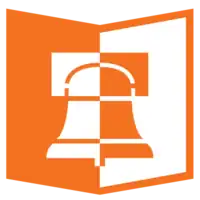 | |
| Location | |
| , | |
| Information | |
| Type | Independent, college-prep, day & boarding |
| Motto | Midwestern Heart. Global Mind |
| Established | 1857 1974 -- Merged with Ferry Hall School |
| Founder | Sylvester Lind |
| CEEB code | 142525 |
| Head of School | Chris Tennyson |
| Faculty | 118[1] |
| Grades | 9–12 |
| Gender | Co-educational |
| Enrollment | 435 52% day, 48% boarding[2] |
| Average class size | 12 students |
| Student to teacher ratio | 6:1[2] |
| Campus | Suburban, 150 acres (1 km2) |
| Color(s) | Orange & black |
| Athletics | 27 sports[3] |
| Mascot | Caxy |
| Website | lfanet.org |
Lake Forest Academy (also known as LFA) is a co-educational college preparatory school for boarding and day students in grades 9 through 12. The school is located on the North Shore in Lake Forest, Illinois, United States, about 30 miles north of Chicago. As of the 2019–2020 school year, the school enrolled 435 students, with the students coming from 13 states and 35 countries. This school is among the most selective boarding schools in the United States.[4] The current head of school is Christopher O. Tennyson. The school is accredited by the National Association of Independent Schools (NAIS),[5] Independent Schools Association of the Central States (ISACS),[6] and the Secondary School Admission Test Board (SSATB).[7]
History
The original inhabitants of the region of the North Shore were the Potawatomi.[8] The town of Lake Forest emerged in the area after the violent dispossession of the Potawatomi in the 1830s, the Chicago cholera epidemic of 1854, and the arrival of the railway from Chicago in 1855.[9] The academy (known as "LFA") was founded in 1857 as a key part of plans for Lake Forest more generally. In tune with the religious revivalism of the time period, the boys preparatory school was Presbyterian.[10] LFA's first principal—Samuel F. Miller—had been one of the civil engineers who helped build the railway, as well as a founder of the Presbyterian Church in town.[11] Early curriculum included Greek, Latin, Mathematics, English, Grammar, and Geography.[12]
Life for early students was rustic. An outdoor pump provided water for drinking and washing.[13] In the fall and summer they often simply bathed in Lake Michigan; in the winter, however, they did not bathe at all. They recalled wandering and hunting in the ravines along Lake Michigan.[14] Another of their pastimes was "hickory nutting," in which boys would climb trees "to shake down the nuts to...friends beneath."[14]
In the lead-up to the Civil War, the student body received military training from the eccentric Elmer Ellsworth.[15] The New York farm boy was enamored with the fezzes and billowy pants of local Algerian soldiers who abetted French colonization of North Africa. And so Ellsworth he began organizing units all around the United States known as Zouaves in their image (or at least his idea of it), including at nascent Lake Forest Academy. Ellsworth would go on to acquire fame for being the first officer to be killed in the conflict. Many of the boys Ellsworth trained ended up fighting in the war, too.[16]
The Young Ladies' Seminary at Ferry Hall, later simplified to Ferry Hall School, was founded in 1869, and was considered a sister school. Lake Forest College was a third component of the original founders' design and opened its doors later although it uses the academy's founding date as its own. It has no formal relationship with the original schools.[17]
It was during the leadership of Principal George Cutting (1887-1890) that the colors of orange and black were selected, perhaps influenced by the fact that Cutting had attended Princeton.[18]
In May 1946, fire destroyed the school's main building. Headmaster E. Francis Bowditch telegrammed students and faculty with the following message: "You, not the buildings, are LFA. Carry on."[19] In 1948, Lake Forest Academy moved its campus to where it is currently located, the gargantuan former estate of Chicago meat baron J. Ogden Armour. Armour lost the premises thanks to the Depression of 1921. Subsequently, a group led by Samuel Insull acquired the property.[20] They were in the process of converting it to a golf course when the Stock Market Crash of 1929 struck. Workers allegedly walked off the job of a half-finished locker room complex and never came back.
At the celebration of the school's centennial in 1957, head of school Harold H. Corbin Jr declared, "The City of Lake Forest, born in an educational dream, should never allow itself to forget that in one vital sense it is a manufacturing town--not merely residential--and its sole demonstrable product is education."[21] The poet Robert Frost and Princeton president Harold Dodds also visited campus and gave speeches in conjunction with the activities. In other festivities, plans were announced to build a headmaster's residence on campus to be named for General Robert E. Wood, the business tycoon whose advocacy for America First before World War II had turned into a penchant for Joseph McCarthy in the postwar period.[22][23]
Ferry Hall and Lake Forest Academy proceeded with their separate missions until the early 1970s, at which point the schools began to coordinate their efforts. A merger of the schools to form the coeducational Lake Forest Academy-Ferry Hall School took place in 1974. Later, the school's name officially became Lake Forest Academy.
Campus
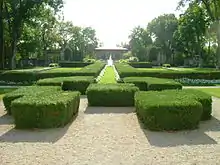
Lake Forest Academy is situated on a wooded 150-acre (0.61 km2) campus, which includes a small lake. There are 30 plus buildings on campus, including Reid Hall (formerly the estate of Chicago meat entrepreneur J. Ogden Armour), Corbin Academic Center, Hutchinson Commons, the Student Union (which houses the dining hall), five dormitories and several faculty housing buildings. The Cressey Center for the Arts (formerly the Fine & Performing Arts Center, or FPAC) is the site for all-school meetings, concerts and student theatrical productions; the Reyes Family Science Center; and a new student union building was opened in the fall of 2016,housed within it is the Stuart Center for Global Learning.[24]
LFA has a variety of athletic facilities, including the David O. MacKenzie '50 Ice Arena, a swimming pool, the Glore Memorial Gymnasium, the James P. Fitzsimmons Athletic Wing, the Crown Fitness & Wellness Center, tennis courts, all-weather track (new as of 2005), and five full-sized playing fields for football, field hockey, and soccer.
Approximately three-quarters of the faculty of Lake Forest Academy live on campus.
Dormitories
Lake Forest Academy houses its approximately 200 boarding students in five different campus dormitories. The dorms are single-sex and are of varying size.
Ferry Hall Dormitory
Ferry Hall Dormitory was completed in the winter of 2012, and the first girls moved into their rooms in February of that year.
Named in honor of Ferry Hall School, and taking design elements from that campus, Ferry Hall Dormitory is the first building to be built on the campus of Lake Forest Academy for girls. With 36 beds, Ferry, as it has come to be known by students is the newest dormitory and is located across the field hockey field from Atlass Hall, forming a quad with the Crown Fitness and Wellness Center and Reid Hall.
In addition to housing students, Ferry Hall Dormitory is also the home to four faculty apartments.
Atlass Hall
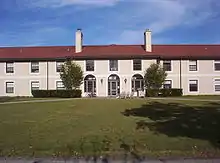
Atlass is the newest boys' dormitory, and located in the center of campus, it is closest to the academic buildings and dining hall. In addition to generously sized rooms and new furniture, Atlass also sports a comfortable lounge area with a television, sofas, and pool table. Atlass is a two-story building that houses 70 boys and four faculty members in apartments on either north or south end of the dorm. Atlass opened in January, 1999 following a grant from H. Leslie Atlass Jr., class of 1936, in honor of his father (class of 1912).[25] According to the inscription on the dormitory, Atlass Sr. was a "broadcasting pioneer and innovator."[26] The financial gift was given with the condition that it be used to construct a new boys' dormitory, since Bates House, the previous boys' dormitory constructed in 1948, was in extremely poor condition.
Warner House
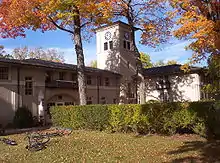
Warner House houses about 30 boys and five faculty members; four in the actual structure, and one family in the attached Remsen Cottage.[27] Warner is acknowledged to be the oldest structure on the Lake Forest Academy campus, thought in campus lore to have been a horse stable in the years before the academy when J. Ogden Armour occupied the campus space. Upon the academy's relocation to its current physical plant in 1948, the Board of Trustees dedicated the building to Ezra J. Warner Jr., class of 1895.[28] Warner is located near the football field and with its relatively large number of faculty, has always been a dormitory that epitomizes the strong connection between students and faculty at LFA.
Marshall Field House
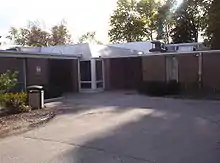
Marshall Field House (or simply "Field") is the home to 72 female boarding students. Field is older than the Atlass dorm with its first season of housing students in 1965 but Field House is the closest dorm to the Student Center and has the most spirit of all of the academy dormitories.
Marshall Field House was named after Marshall Field, the founder of Marshall Field and Company, the Chicago-based chain of department stores. A substantial donation was made by Field to the academy, and the Marshall Field House was dedicated to him on October 9, 1965.[29]
McIntosh Cottage

McIntosh Cottage (known simply as "Mac") is a unique dormitory, housing only nine girls in five rooms. In addition to the nine student residents, McIntosh houses two faculty members in apartments.[30] McIntosh was named for Arthur T. McIntosh, class of 1896, by his son.[31]
Athletics
The academy was formerly a member of the Chicago Independent School League and competed against eight other independent schools in Chicago's suburbs in some sports. The following sports are offered:[32]
|
Fall:
|
Winter:
|
Spring:
|
 The Bowditch Bell, traditionally rung by sports teams after away victories
|
Students at LFA may also partake in non-team P.E. activities such as bowling, curling, salsa dance, jogging, lacrosse, water polo, weightlifting, and yoga, as well as a winter/spring musical.
LFA has a very strong athletic tradition that began in 1859 when Elmer E. Ellsworth, a close friend of Abraham Lincoln who already had become well known in the leading eastern cities by organizing military units called Zouaves, would be hired to drill the students. Ellsworth would be called to Washington, D.C., by Lincoln who made him a colonel. He was the first officer in the Civil War to give his life for the Union cause. The academy's drill team had been a pet project of Colonel Ellsworth, so that after the Civil War, when President Lincoln's body was brought through Chicago from Washington to Springfield, it would act as escort and guard of honor from Chicago to the State Capitol.
Because of the Ellsworth experiment, a gymnasium would be erected in 1864 and physical training was strongly stressed. In 1876, the LFA baseball team played against Albert Spalding's Chicago White Stockings (later renamed the Cubs) professional team. LFA lost; the score was 31 to 1. In 1888, football would be introduced by math and physics instructor William H. ("Little Bill") Williams. He would later coach and would be president of the University Athletic Association; and he has been called the father of the Western Collegiate Football Association, subsequently named "The Big Ten." The academy's football tradition would be carried on by such legendary coaches as Clarence Herschberger and especially Ralph Jones whose teams during the 1920s stood among the finest in the entire country. He had been the University of Illinois' head basketball coach and its freshman baseball and football coach. For eight years he would achieve great success in the Big Ten and had written the acknowledged standard work on scientific basketball playing. Under his stewardship of LFA's football program during the 1920s, it became more and more difficult for the school to arrange games with secondary schools, and the schedule would be nearly filled against college freshman and junior college teams. In the early 1930s when an ex-player of Jones' bought the Chicago Bears, he would ask Jones to coach them. He did so with distinction, which included the first NFL championship.
Lake Forest Academy is notable for not being a full member of the Illinois High School Association, the body which governs most sports and competitive activities in Illinois. According to a September 2009 interview with the school's athletic director, "LFA's athletic philosophy and active recruitment of international students conflict with the IHSA and that the Caxys are not eligible to compete for state championships in any sport. And LFA was not about to change its private-school philosophy (required athletics for every student) to conform to IHSA standards."[33]
Mascot

The LFA mascot is the "Caxy", which is ancient Greek for "ribbit" – the croaking sound made by a frog. In the early 1900s, Aristophanes' hit comedy, The Frogs, was the subject of a popular Greek literature class.[34] LFA is believed to be the only school with "Caxys" as a nickname, although a popular athletic cheer at Yale University uses lines from the same Aristophanes play.[35] The cheer dates back to at least 1896, when a student revolt against suspensions of several students led to dozens of students taking the train to Chicago, where upon alighting at Wells Street they wandered the streets and chanted, "Caxy, go wack! Go wack! Go wack! Caxy, go wack! Go wack! Go wack! Hi-O! Hi-O! Paraballoo! 'Cademy! 'Cademy! L.F.U.!!"[36]
Traditions
Move-Up Day
Move-Up Day began as a tradition at Ferry Hall in 1906, originally called Ivy Day, commemorating the annual planting of Ivy at the base of Smith Hall.[37] Over time, this tradition would evolve into its current form, usually being held the day before Graduation. Departmental awards and speeches are given, and at the end of the ceremony, each class is invited to "move up" and literally take the place that they will occupy the next year: seniors move to sit with the alumni, juniors take the former spots of the seniors, and so on.
All-School Handshake
At the beginning of each year every student, faculty member, and administrator gathers in the Formal Gardens and participates in the All-School Handshake.[38] The entire school arranges themselves in a line around the periphery of the Formal Gardens and the Head of School begins by shaking the person's hand next to him, then he moves on to the next until each person has shaken the hand of all others.
Field Day
Field Day also began at Ferry Hall, starting in the spring of 1903 with "classes competing in races, the high jump, and a five-pound shot put, among other events." Field Day would die out in the 1970s as a result of the merger between Ferry Hall and Lake Forest Academy.[39]
The House Cup
The House Cup Competition would be re-established in 2004. The students are divided up into four houses (Bird, Lewis, Sargent, and Welch) and compete in various events throughout the year. The house with the most event points at the end of the year have their name inscribed on a trophy that is displayed in Reid Hall; the colors of the winning team are used in the student handbook cover for the following year. This is based on the House system which is found in British schools; however unlike British schools, students are not divided up based on what dorm they are in. This is similar to the house system in the Harry Potter series, and as such the students often debate which LFA house corresponds with that in the series; there is never any consensus on this.
Reputation
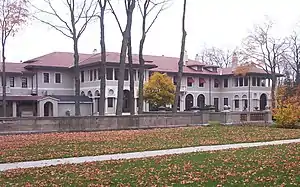
Lake Forest Academy is well-recognized as one of the strongest college preparatory schools in the United States.[40] All graduates attend a 4-year college or university, and many of them attend Ivy League schools, "Little Ivies", and other elite colleges and universities.[41]
Ties to the leading colleges and universities with the academy date back to its very first graduating class. Innovation has been the school's hallmark particularly under strong headmasters such as William Mather Lewis (headmaster between 1905 and 1913 and, subsequently, president of George Washington University and thereafter Lafayette College) and E. Francis Bowditch[42] (headmaster between 1941 and 1951 and later dean at MIT). John Wayne Richards led the school from 1913 until 1941. His pioneering instructional plan of a rotating class schedule received coverage in Time magazine in both 1930 and 1931 under headlines that employed a term of endearment for the headmaster that referenced both his size and a common nickname for Richard.[43][44] Harold Harlow Corbin Jr. served as head of the school from 1951 until 1969. Corbin was also a renowned collector of eagle figurines, and he occasionally lectured on the topic.[45][46]
One of the fundamental strengths of the school is the potential for strong relationships that form between students and faculty. Faculty, approximately three-quarters of whom live on campus, also serve as coaches and dorm supervisors. This aspect of the academy is often promoted by the Admissions Department and others as a feature that sets the school apart from other institutions. Former head of School Dr. John Strudwick mentions that "LFA prides itself on its small classes and its Advisory system which both promote a unique and productive relationship between faculty and students."[47]
On film
The campus has been used as a shooting location for several films, among them: Damien: Omen II, Ordinary People, The Babe, and The Package.[48]
Notable alumni
Arts
- John Agar, actor, formerly married to Shirley Temple[49]
- Bix Beiderbecke, jazz cornet player (expelled; attended 1921–22)[50]
- David Bradley, film director
- Temple Hoyne Buell (1914), architect, viewed as the father of the modern indoor shopping mall[51]
- Jay Chandrasekhar, comedian and film director[52]
- Max Demián (2005), performance artist
- Lindsay Glazer (1996), comedian
- Jesse Hibbs (1925), film director
- Brad Morris (1994), television actor
- Robert Myhrum (1944), television director
- Tom Neal, actor[53]
- Kelly Perine (1987), actor
- McLean Stevenson, actor[54]
- Stephen Wade (1970), folk musician
- Melora Walters (1979), actress
Business and law
- James Aubrey (attended 1931–32), president of CBS and MGM
- Charles Edmund Beard (1916), aviation pioneer and president of Braniff Airlines[55]
- Andrew T. Berlin (1979), businessman and philanthropist; minority stakeholder in the Chicago Cubs Major League Baseball team
- Ralph Bogan, co-owned baseball's Milwaukee/Atlanta Braves
- James R. Cargill (1941), billionaire scion of Minnesota's Cargill family; pioneered in the computerization of animal feed formulations[56]
- Gaylord Donnelley (attended 1923–24), former chairman of R. R. Donnelley & Sons
- Charles Gelatt (1935), Wisconsin businessman and philanthropist, early co-owner of the Milwaukee Brewers
- George N. Gillett Jr. (1956), communications mogul, former co–owner of the English Premier League team Liverpool F.C. and NASCAR auto-racing team Richard Petty Motorsports
- Louis Upton (1907), co-founder of Whirlpool Corporation
- Rawleigh Warner Jr. (attended 1935–36), chairman/CEO of Mobil Oil
Government and public service
- Makola Abdullah (1986), 14th President of Virginia State University (VSU)
- Richard L. Conolly (1910), Admiral of the United States Navy during World War II[57]
- Jan Crull Jr., Native American rights advocate, filmmaker, attorney[58]
- Geoff Diehl, class of 1988, State Representative for the 7th Plymouth District of the Commonwealth of Massachusetts
- John Francis Grady (1948), United States District Court Judge; senior judge for the Northern District of Illinois
- Melvin R. Laird (attended 1938–39), US Congressman (1952–69) and Secretary of Defense (1969–73)[54]
- Edward Everett Nourse, theologian[59]
- Nauman S. Scott, class of 1934, one of the first Louisiana U.S. District Court Judges to advocate desegregation
- Charles H. Wacker (1872), chairman of the Chicago Plan Commission and beer-maker[60][61][62]
Journalism and letters
- Bill Ayers, professor at the University of Illinois at Chicago who co-founded the Weather Underground[63]
- Ward Just, Washington Post Vietnam War correspondent and author
- Michael Leonard, class of 1966, feature reporter for NBC's Today show
- Rebecca Makkai, class of 1995, author
- Ralph J. Mills, poet and critic
- Robert Wilson Patterson, class of 1867, newspaper publisher
- Bill Schulz, class of 1994, Fox News
Science
- Patrick M. McCarthy (surgeon), class of 1973, heart surgeon
- Cristopher Moore, class of 1983, computer scientist, mathematician, and physicist
- Karl Patterson Schmidt, herpetologist
- Paul Starrett, class of 1883, structural engineer
- Charles Thom, microbiologist and mycologist
Athletics
- Neil Blatchford (1964), speed skater who competed in the 1972 Winter Olympics[64]
- Angus Brandt, Australian professional basketball player
- Alex DeBrincat, right winger for NHL's Detroit Red Wings
- Alfred Eissler, NFL player
- Dylan Ennis, professional basketball player
- Tyler Ennis, NBA player for the Los Angeles Lakers
- Babe Frump, NFL player with the Chicago Bears
- Ángel García, professional basketball player
- Geneviève Lacasse, Olympic gold medalist goalkeeper, Canadian national women's hockey team
- David Levine, ARCA Racing Series race car driver for Lira Motorsports
- Victor Pineda, soccer player for Chicago Fire and United States U-18 national team
- Olivier-Maxence Prosper, professional basketball player for Dallas Mavericks
- Teddy Purcell, right winger for NHL's Tampa Bay Lightning
- Paul Schuette, NFL player with the New York Giants, Chicago Bears, and Boston Braves
Other
- Robert S. Hartman, logician and philosopher
References
- ↑ "Faculty and Staff Directory". Archived from the original on 2018-04-08. Retrieved 2018-04-08.
- 1 2 "Facts and Figures". Archived from the original on 2018-04-08. Retrieved 2018-04-08.
- ↑ "Lake Forest Academy ~ Athletic Department". Lake Forest Academy. Archived from the original on 2011-07-18. Retrieved 2009-03-15.
- ↑ "Most Selective Boarding Schools (2018-19)" at
- ↑ "Organization Member Information – Lake Forest Academy". NAIS – National Association of Independent Schools. Archived from the original on 2011-07-20. Retrieved 2009-01-01.
- ↑ "Directory of Schools". ISACS – Independent Schools Association of the Central States. Archived from the original on 2011-02-12. Retrieved 2009-01-01.
- ↑ "SSAT School Locator Service". SSAT – Secondary School Admission Test. Archived from the original on 2008-12-17. Retrieved 2009-01-01.
- ↑ Arpee, Edward (1944). The History of Lake Forest Academy. Chicago: RF Seymour. pp. 17–18.
- ↑ Arpee, Edward (1944). The History of Lake Forest Academy. Chicago: RF Seymour. p. 20.
- ↑ Arpee. The History of Lake Forest Academy. p. 22.
- ↑ Arpee. The History of Lake Forest Academy. pp. 20, 31.
- ↑ Arpee. The History of Lake Forest Academy. p. 36.
- ↑ Arpee. The History of Lake Forest Academy. p. 29.
- 1 2 Manierre, George (October 1917). "Reminiscences of Lake Forest Academy and its Students from the Opening of the Academy in Fall of 1859 to the Year 1863, Inclusive". Journal of the Illinois State Historical Society. 10 (3): 394–407.
- ↑ Arpee. History of Lake Forest Academy. pp. 37–38.
- ↑ Arpee. The History of Lake Forest Academy. pp. 39–40.
- ↑ "About Us: History". Lake Forest Academy. Archived from the original on 2009-11-02. Retrieved 2007-01-01.
- ↑ Arpee. The History of Lake Forest Academy. p. 82.
- ↑ Heise, Kenan (15 February 1990). "Obituaries: E. Francis Bowditch; ran Lake Forest Academy". Chicago Tribune.
- ↑ Arpee, Edward (1963). Lake Forest, Illinois; history and reminiscences, 1861-1961. Rotary Club of Lake Forest. p. 215.
- ↑ Arpee, Edward. Lake Forest, Illinois; history and reminiscences, 1861-1961. p. 262.
- ↑ Pflaum, Irving (31 March 1954). "The Baffling Career of Robert E. Wood". Harper's.
- ↑ Doenecke, Justus (Aug 1978). "General Robert E. Wood: The Evolution of a Conservative". Journal of the Illinois State Historical Society. 71 (3): 174.
- ↑ a gift from Jim Stuart, LFA '59, a member of the family who founded the Quaker Oats Company and whose father R. Douglas Stuart, Jr. was the U.S. Ambassador to Norway under U.S. President Ronald Reagan
- ↑ Atlass Hall, from the official website.
- ↑ As referenced on the inscription outside Atlass Hall.
- ↑ Warner House Archived 2007-09-27 at the Wayback Machine, from the official website.
- ↑ As referenced on the inscription outside Warner House.
- ↑ As referenced on the inscription outside Marshall Field House.
- ↑ McIntosh Cottage Archived 2007-09-27 at the Wayback Machine, from the official website.
- ↑ As referenced on the inscription outside McIntosh Cottage.
- ↑ "Team News". Lake Forest Academy. Archived from the original on 2011-07-18. Retrieved 2009-01-01.
- ↑ Masterson, Dave (3 September 2009), "Caxys to line up against Mount Carmel", Chicago Sun-Times, archived from the original on 18 December 2009, retrieved 13 April 2010
- ↑ "A Caxy?". Lake Forest Academy Athletics. Archived from the original on 2007-09-27. Retrieved 2007-01-01.
- ↑ Schiff, Judith Ann (May 1998). "The Greatest College Cheer". Yale Alumni Magazine. Archived from the original on 2006-12-31. Retrieved 2007-01-01.
- ↑ "Revolt at Lake Forest". Chicago Daily Tribune. 4 February 1896.
- ↑ Pridmore 102
- ↑ "News & Calendar". Lake Forest Academy. 2007-08-27. Retrieved 2008-01-17.
- ↑ Pridmore 104
- ↑ See "These Are the Best Boarding Schools in the United States" at http://www.townandcountrymag.com/society/news/a7803/best-boardi...
- ↑ "Review of Lake Forest Academy". Boarding School. Retrieved 2006-03-16.
LFA graduates currently attend colleges throughout the country, including Harvard, Princeton, Brown, Duke, Dartmouth, Columbia, George Washington, Georgetown, Cornell, St. Andrew's-Scotland, Middlebury and Wesleyan, Northwestern, University of Chicago, UCLA, Williams, as well as many other excellent colleges and universities.
- ↑ Francis Bowditch, 77, Dean and Headmaster --New York Times, February 10, 1990.
- ↑ "Education: Big Dick's Anniversary". Time. 1938-05-09. ISSN 0040-781X. Retrieved 2020-10-24.
- ↑ "Education: Big Dick's Plans". Time. 1930-08-18. ISSN 0040-781X. Retrieved 2020-10-24.
- ↑ Simmons, Ray (22 October 1953). "Eagle Figures Collected by Academy Head: Lake Forest Man has 150 in his Home". Chicago Daily Tribune.
- ↑ Kotulak, Jean (14 September 1961). "Eagles Fill the Nest of this Collector: Also Roost School Office". Chicago Daily Tribune.
- ↑ "A message from Head of School Dr. John Strudwick". Lake Forest Academy. Archived from the original on 2011-07-18. Retrieved 2007-01-01.
- ↑ Bernstein, Arnie (1998), Hollywood on Lake Michigan (first ed.), Chicago: Lake Claremont Press, ISBN 0-9642426-2-1,
p.245-246
- ↑ Vallance, Tom (10 April 2002), "John Agar: Strappingly handsome actor married to Shirley Temple (obituary)", The Independent, archived from the original on July 27, 2010, retrieved 13 April 2010,
Born in Chicago in 1921, Agar was the eldest of four sons of an affluent executive of a meat-packing company. Educated at the Harvard School for Boys and Lake Forest Academy, he excelled in athletics but did not receive good enough grades to attend college.
- ↑ "Bix Beiderbecke". PBS. Retrieved 2007-01-01.
- ↑ "Biographical Note" (Temple Hoyne Buell Architectural Records,WH1397, Western History Collection). biographical sketch. Denver Public Library. Retrieved 13 April 2010.
Temple Hoyne Buell was born in Chicago on September 9, 1895. He grew up in Chicago and attended Lake Forest Academy.
- ↑ "Jay Chandrasekhar: Director, actor, writer". biographic sketch. Office of the Clerk of Cook County. 2009. Archived from the original on 8 July 2011. Retrieved 13 April 2010.
- ↑ O'Dowd, John (2007). Kiss Tomorrow Goodbye: The Barbara Payton Story. BearManor Media. p. 148. ISBN 978-1-593-93063-9.
- 1 2 Sweeney, Annie (27 January 1998), "Diversity Apparent In An Unlikely Place", Chicago Tribune, retrieved 14 April 2010,
Past students include such luminaries as former U.S. Secretary of Defense Melvin Laird, the late actor McLean Stevenson and Illinois State Treasurer Judy Baar Topinka, who attended Ferry Hall, which merged with LFA in 1974.
- ↑ Moore, Matthew Douglas (22 February 2010). "BEARD, CHARLES EDMUND (1900–1982)". biographic sketch. Texas State Historical Association/University of North Texas. Retrieved 13 April 2010.
Charles Beard, airline executive, was born in Toledo, Ohio, on November 23, 1900, the son of Hiram Edmund and Mamie (Reiser) Beard. He received his early education at Lake Forest Academy.
- ↑ Medcalf, Myron P. (29 March 2006), "James R. Cargill, grandson of firm's founder; The fourth-wealthiest Minnesotan retired from the company in 1989 but still worked on other interests", Star Tribune (Minneapolis, Minnesota, USA), archived from the original on 3 November 2012, retrieved 13 April 2010,
He was born in 1923 in Chicago and raised in Minneapolis. After graduating from Lake Forest Academy in Lake Forest, Ill., …
- ↑ Moran, Dan (5 February 2007), "Destroyer museum plans could be sinking Waukegan", The News Sun (Waukegan, Illinois),
The Conolly is named for World War II Adm. Richard Lansing Conolly, who was born in Waukegan and attended Lake Forest Academy.
- ↑ "a.b.c...." Who's Who in America 2011 65th Edition, Vol. 1 + A-L. New Providence, N.J.: Marquis Who's Who. pp. 1003–1004.
- ↑ The Encyclopedia Americana, vol. 20, New York: The Encyclopedia Americana Corporation, 1919, p. 462,
American theologian: b. Bayfield, Wis. 24 Dec. 1863. He was educated at Lake Forest Academy and University ...
- ↑ Andres, Alfred Theodore (1886), History of Chicago, vol. 3, Chicago: The A. T. Andreas Company, p. 578,
Charles H. Wacker ... received his education in the graded and high schools of the city, also studying one year at Lake Forest Academy.
- ↑ Waterman, Arba Nelson (1908), Historical review of Chicago and Cook county and selected biography, vol. 3, Chicago: The Lewis Publishing Company, p. 1116,
Charles Henry Wacker was born in Chicago ... He attended the public schools of Chicago and the Lake Forest (Ill.) Academy.
- ↑ Hirsch, Susan (Summer 2016). "Ethnic and Civic Leadership: Charles H. Wacker and Chicago". Journal of American Ethnic History. 35 (4): 5–31. doi:10.5406/jamerethnhist.35.4.5.
- ↑ Leonard, John (2001-09-27). "Looking for Mr. Goodbomb". The Nation. Retrieved 2007-01-01.
- ↑ "Northbrook Skater Wins Midwest Title: Neil Blatchford Leads Triumph by Illinois as Field Accounts for 29 Records", Milwaukee Journal, p. 11, 3 February 1964,
While Blatchford, a star athlete at Lake Forest (Ill.) academy was winning the ...
- Arpee, Edward (1944). The History of Lake Forest Academy. Chicago: R.F. Seymour. OCLC 3165440.
- Pridmore, Jay; Megan C. McGuire '88; Martha Briggs (1994). Anne Gendler (ed.). Many Hearts and Many Hands: The History of Ferry Hall and Lake Forest Academy. William A. Seabright, John A. Scrapes, Dan Grayson, Alan Shortall. Brookfield, Wisconsin: Burton and Mayer. p. 264. ISBN 0-9643350-0-X. OCLC 32152179.
{{cite book}}: CS1 maint: numeric names: authors list (link) - Thompson, Jacqueline (1981). "Eight Sure-Fire Upper Class Indicators: Coed Prep Schools for Patrician Adolescents". The Very Rich Book: America's Supermillionaires and Their Money, Where They Got It, How They Spend It. New York: Morrow. ISBN 0-688-00072-X. OCLC 6707747.